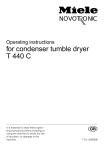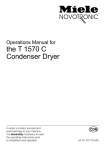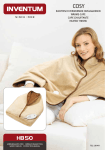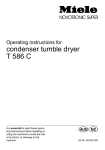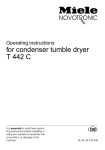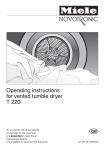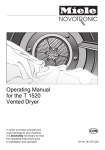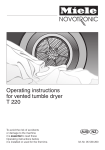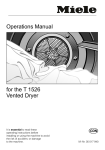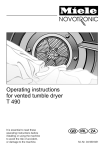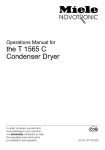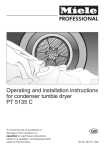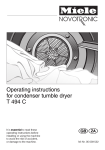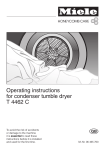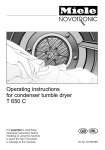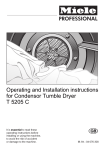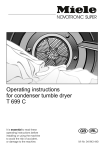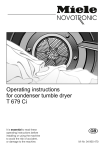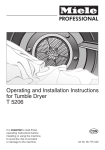Download Miele T 430 Operating instructions
Transcript
Operating instructions for vented tumble dryer T 430 It is essential to read these operating instructions before installing or using the machine to avoid the risk of accident, or damage to the machine. Q\ M.-Nr. 04579710 Contents Guide to the appliance. . . . . . . . . . . . . . . . . . . . . . . . . . . . . . . . . . . . . . . . . . . . . . . 3 For the user Warning and safety instructions. . . . . . . . . . . . . . . . . . . . . . . . . . . . . . . . . . . . . . . . 6 Notes on laundry care . . . . . . . . . . . . . . . . . . . . . . . . . . . . . . . . . . . . . . . . . . . . . . 8 Loading and unloading washing . . . . . . . . . . . . . . . . . . . . . . . . . . . . . . . . . . . . . . . 9 Programme selection . . . . . . . . . . . . . . . . . . . . . . . . . . . . . . . . . . . . . . . . . . . . . . . 10 Programmes for Cottons . . . . . . . . . . . . . . . . . . . . . . . . . . . . . . . . . . . . . . . . . . . . 11 Programmes for Minimum iron and timed drying . . . . . . . . . . . . . . . . . . . . . . . . . 12 Consumption data . . . . . . . . . . . . . . . . . . . . . . . . . . . . . . . . . . . . . . . . . . . . . . . . . 13 Cleaning and care . . . . . . . . . . . . . . . . . . . . . . . . . . . . . . . . . . . . . . . . . . . . . . . . . 14 Problem solving guide . . . . . . . . . . . . . . . . . . . . . . . . . . . . . . . . . . . . . . . . . . . . . . 15 After sales service . . . . . . . . . . . . . . . . . . . . . . . . . . . . . . . . . . . . . . . . . . . . . . . . . 17 For the installer/electrician Installation . . . . . . . . . . . . . . . . . . . . . . . . . . . . . . . . . . . . . . . . . . . . . . . . . . . . . . . Installation - venting . . . . . . . . . . . . . . . . . . . . . . . . . . . . . . . . . . . . . . . . . . . . . . . . Electrical connection . . . . . . . . . . . . . . . . . . . . . . . . . . . . . . . . . . . . . . . . . . . . . . . Technical Data . . . . . . . . . . . . . . . . . . . . . . . . . . . . . . . . . . . . . . . . . . . . . . . . . . . . 18 19 25 27 Help to protect our environment! Disposal of the packing material The packaging used to protect the machine during transport largely consists of the following recyclable materials: - Corrugated paper/card - Polystyrene - CFC-free - Polyethylene foil - transparent - Fibreboard (solvent free) - Untreated wood - Packaging straps: Polyamide (blue), Polypropylene (black) Rather than just throwing these materials away please take them to the nearest collection point for specific waste. Disposal of your old appliance Old appliances contain materials which can be recycled. Please contact your local authorities or scrap merchant about potential recycling schemes, before disposing of the appliance. 2 Guide to the appliance 1 a.c. connection cable (2 m long) with plug 2 Control panel 3 Drum door 4 Exhaust connection rear, right and left 5 Height-adjustable screw feet 3 Guide to the appliance Pushbuttons Programme selector switch Door opens the door Cottons Extra dry Normal+ Normal Hand iron r Hand iron rr Machine iron On/Off for switching the appliance on and off. Low temperature low temperatures for delicate fabrics, e.g. acrylics. Buzzer sounds when the drum turns during the intermittent anti-crease action period. Start starts a drying programme Minimum iron Normal+ Normal Hand iron Timed drying 15 mins cool air 20 mins warm air Programme sequence indicator lights On Drying Cooling down Anti-crease/Finish 4 Drying stage display This shows the stage of drying reached. For programmes “Normal +” and “Extra dry” the indicator light remains at the “Normal” position. Guide to the appliance Environmentally conscious drying The sensitive system automatically adjusts drying to suit the water quality. The water conductivity is measured, and registered by the control which then compensates to achieve a uniform residual moisture level. The Novotronic control offers 9 programmes with electronic moisture measuring and 2 timed programmes. The automatic reversing action turns the drum clockwise and anti-clockwise to loosen the laundry and prevent damp patches and thus to ensure even drying results. Energy saving tips Make sure that your laundry is thoroughly spun before drying. You will save up to 35% energy and time if laundry is spun at full spin speed instead of at 600 rpm. Load according to the optimum amount of washing for the programme to be selected. Underloading is uneconomical. Overloading gives a poorer quality of drying and may cause unnecessary creasing. Before using for the first time Important: The appliance must be properly installed and connected to the electricity supply. 5 Warning and safety instructions Please read the operating instructions before using the tumble dryer for the first time. They contain important information about the safety, use and maintenance of the machine. This will avoid the risk of accidents and damage to the machine. Keep these operating instructions in a safe place and ensure that new users are familiar with the content. Pass them on any future owner of the machine. Correct usage The tumble dryer is only intended for drying fabrics, which have been washed in a water solution, marked on the manufacturer’s wash care label as being suitable for tumble drying. Any other applications may be dangerous. The manufacturer is not liable for damage resulting from improper use or operation. Do not let small children play with the machine and its controls or operate it. Please supervise its use by the elderly or infirm. Technical safety Before connecting the machine, ensure that the connection data on the data plate (fusing, voltage and frequency) matches the mains electricity supply. If in any doubt, consult a qualified electrician. 6 The electrical safety of this machine can only be guaranteed when continuity is complete between the appliance and an effective earthing system which complies with local and national regulations. It is most important that this basic safety requirement is regularly tested by a qualified electrician. The manufacturer can not be held responsible for the consequences of an inadequate earthing system. The machine is built in accordance with current safety requirements. Unauthorised repairs could result in unforeseen dangers for the user, for which the manufacturer can not accept responsibility. Repairs should only be undertaken by a Miele approved engineer. Adequate ventilation is essential, especially where another appliance which also uses the room air (eg gas, oil or coal fired heater, continuous flow or other water heater), is installed in the same or an adjacent room. To ensure safe operation, and to prevent gases being given off by these appliances being drawn back into the room, an underpressure of 0.04 mbar is the maximum permissible. Ventilation can be maintained by air inlets which can not be blocked, in windows, doors and outside wall vents, or by an automatic window opening arrangement when the tumble dryer is switched on. If in doubt, the advice of a competent builder, or for gas, a “Corgi” installer (in the U.K.) must be sought. Warning and safety instructions In the event of a fault or for cleaning purposes, the machine is only completely isolated from the electricity supply either when: – the plug is withdrawn, or – it is switched off at the mains – the mains fuse is withdrawn. Faulty components must only be exchanged for Miele original spare parts. Only when these parts are fitted can the safety standards of the machine be guaranteed. Use There is a danger of fire with fabrics, which: Do not install the machine in a room where the temperature may drop below freezing. At very cold temperatures the machine may be difficult to start. Laundry will not dry and the "anti-crease"-indicator will flash to indicate a problem. The exhaust air must not be vented into a chimney or vent flue which is in use. Neither should it be connected to ducting which ventilates rooms with fireplaces. It would be dangerous if smoke or exhaust fumes were drawn back into the room. Using accessories Accessory parts may only be fitted when expressly approved by Miele. If other parts are used, guarantee, performance and product liability claims may be invalidated. – contain rubber, foam rubber or rubber-like materials – have been treated with inflammable cleaning agents – have been splashed with hair lacquer, hair spray, nail varnish remover or similar. Disposing of your old machine Always close the door after use. This way you will avoid the danger of anyone sitting or leaning on the door, which can cause the machine to tip up. Before discarding an old machine unplug it. Render the plug useless. Cut off the cable directly behind the appliance to prevent misuse. Vented dryers must be installed with a suitable venting system. If the machine is not correctly ducted it will draw damp exhaust air back into the drum, increasing running time and energy consumption quite considerably. If moist air is passed back into the room this may lead to long-term damage of walls. 7 Notes on laundry care Before drying, check the drying symbol on the textile care label. Significance of symbols: q = Dry at normal temperature r = Dry at low temperature s = Do not tumble dry If no symbol is featured dry at your own risk applying the following principles: – Cottons and minimum iron items should be dried at a normal temperature at the appropriate programme setting. – For delicate fabrics, e.g. acrylic fibres, the low temperature setting should be selected. The following fabrics should not be dried in a tumble dryer: – Woollens and wool blends These fabrics tend to become matted and shrink. – Items filled with down The fine fabric interior tends to shrink, depending on the quality involved. – Pure linen These items should only be machinedried if specified as suitable by the manufacturer on the textile care label, as the surface of the fabric may otherwise tend to “roughen”. Note Some woven and loopknit materials tend to shrink to varying extents depending on their quality. This tendency is exaggerated by over-drying. When purchasing woven materials, it is advisable to take their shrinkage properties into account. Starched washing can also be dried in the tumble dryer. In order to achieve the usual finish, double the amount of starch should be used. Select the most suitable programme for hand or machine ironing. Minimum iron items should be spun for 10 to 30 seconds before being tumble dried. Such fabrics tend to crease if overdried. These items should be given only a short period in the dryer, and taken out slightly damp. The “Minimum iron Normal” programme is recommended. Minimum iron shirts in 100 % cotton may crease during tumble drying depending on the quality and weave. Minimum iron fabrics tend to crease more, the greater the load. This is particularly true of very delicate fabrics. The load should be reduced to 1.5 kg or, if necessary, to 1 kg. The “Hand iron” setting is recommended for these types of garment. In extreme cases do not tumble dry these garments. Dark-coloured garments should be dried separately from light-coloured garments. 8 Loading the machine Load the laundry very loosely into the drum. Duvet covers and pillowcases should be fastened before drying in order to prevent small items from being rolled inside them. Unloading the machine At the end of the programme remove the washing from the machine. If this is not done, the machine automatically proceeds into an intermittent anticrease action for 60 minutes. This entails the drum being rotated at short intervals in order to reduce the possibility of the formation of creases. Once the laundry has been removed, check that the drum is empty. Any items left in the drum could be damaged through overdrying in the next programme. Clean the fluff filter after each drying cycle to prevent excessive energy consumption and longer programme running times. The door should always be closed after use. Important: Please check that items of laundry cannot be trapped by the door as this will cause damage to the fabric. 9 Programme selection Selecting a programme This tumble dryer is fitted with an electronic sensor system. The required degree of dryness is measured and monitored electronically so that the heating element is switched off as soon as it is reached. The drying cycle automatically finishes with a cooling down period. This may be followed by the anti-crease action cycle. The following drying programmes are available: Cottons six drying levels from “Extra dry” to “Machine iron” Minimum iron three drying levels from “Normal+” to “Hand iron” Timed drying 15 mins cool air and 20 mins warm air Low temperature By selecting “Low temperature” the temperature can be lowered for delicate fabrics (e.g. acrylic). Correct procedure: Press the "ON/OFF" button. Press the "Door" button. Open the door and load the drum. Close the door. Select a programme by turning the selector switch clockwise or anticlockwise. Select “Low temperature” if required. Press “Start”. 10 After drying: Turn the programme selector switch to “Finish”. Switch the machine off. Clean the fluff filter. Opening the door during a programme If the door is opened during a programme the programme will have to be started again: Close the door. Press “Start”. The selected programme restarts. The programme is not continued if: – There is a power failure lasting more than 30 minutes. – The programme has already reached the “Cooling down” or “Anticrease” stage. To reselect a different programme during drying: Set the programme selector switch to the required programme. The new programme starts from the beginning. To cancel a programme Turn the programme selector switch to “Finish”. Programmes - Cottons Extra dry Hand iron rr Multi-layer fabrics which would not be thoroughly dried using the “Normal +” programme. Cotton or linen fabrics, e.g. table linen, bedding, starched laundry, etc. max. 5 kg Note: Jerseywear tends to shrink depending on the quality and type of manufacturing involved. The “Extra dry” programme should therefore not be selected for these fabrics. Normal+ Mixed load of cotton fabrics, e.g. towelling and jerseywear, i.e. single-layer and multi-layer fabrics. max. 5 kg max. 5 kg Note: If fabrics are too damp for hand-ironing, please select the “Hand iron r” programme. Machine iron Cotton or linen fabrics, including starched laundry, for machine-ironing. max. 5 kg Note: The laundry should be rolled up to prevent it from drying out until it can be ironed. Normal Homogeneous loads of cotton fabrics (jerseywear, flannelette sheets, towelling). max. 5 kg Note: Should certain items still be slightly damp, select the “Normal + programme”. 11 Programmes - Minimum iron and timed drying Normal + 15 minutes cool air Minimum iron items made of synthetics or blended fabrics, e.g. pullovers, dresses, trousers, etc., which are not dried adequately in the “Normal” programme. Items which are only to be aired. max. 2,5 kg Normal Minimum iron shirts, table cloths, etc., made of blended woven or knitted fabrics, e.g. cotton/synthetics. max. 2,5 kg Hand iron Minimum iron shirts, table cloths, etc. made of blended woven or knitted fabrics, e.g. cotton/synthetics, which are still to be hand-ironed. max. 2,5 kg Note for all three programmes: With blended fabrics consisting of wool and synthetics, consult the manufacturer’s instructions, as the wool component may become matted. 12 max. 5 kg 20 minutes warm air Individual items, e.g. bathing towels, bathing trunks. Consumption data Drying stage Capacity (kg) Final spin speed in a domestic washing machine (rpm) Electricity consumption Drying time incl. cooling down time (kWh) (mins) Cottons Extra dry 5 1200 1400 1550 3.32 3.16 3.06 71 68 66 Normal+ 5 1200 1400 1550 3.06 2.91 2.81 66 63 61 Normal 5 1200 1400 1550 2.78 2.63 2.54 61 59 56 Hand iron rr 5 1200 1400 1550 2.02 1.88 1.79 47 44 43 Machine iron 5 1200 1400 1550 1.59 1.46 1.36 39 36 35 Normal+ 2.5 1000 1.48 37 Normal 2.5 1000 1.24 33 Hand iron 2.5 1000 1.07 29 Minimum iron All consumption data have been obtained through standard tests (EN 61121/A11). Different types of fabric, the load and residual moisture after spinning may affect the figures given. 13 Cleaning and care The fluff which occurs during drying is collected in the fluff filter in the door. Clean the filter after every programme to save time and energy. Before cleaning the tumble dryer: Always disconnect the machine from the power supply. The dryer can be cleaned with a cloth using soapy water or a mild detergent (not scouring powder) and dried with a soft cloth. The drum may be cleaned using a suitable proprietary stainless steel cleaner following the manufacturer’s instructions. Grip the filter by the recessed handle and pull upwards to clean. Remove any remaining fluff from the hollow part of the door through the wide slit at the bottom. The filter can rinsed with water if necessary. Dry the filter before putting it back in place. 14 Do not use abrasive cleaners, or glass or all-purpose cleaners. These might cause damage to the plastic surfaces because of the chemicals they contain. The machine must never be hosed down. Problem solving guide Electrical appliances should only be repaired by qualified personnel. Incorrectly repaired machines may pose a considerable risk to the user. There are, however, minor faults which can be corrected without contacting the Service Department. The tumble dryer fails to start when switched on. Check whether the “On” indicator lamp lights up. If so, failure to start may be due to an incorrect selection procedure sequence when switching on the machine. Repeat the switch-on procedure in the correct sequence (see P. 10). If the “On” indicator lamp does not light up, check that the “On/Off” button is depressed the door is properly closed the mains plug is plugged in and the fuse or circuit breaker has not tripped. Drying times are too long. Clean the fluff filter in the door. The laundry was not spun for a sufficiently long time. Ventilation is inadequate (e.g. in a small room). When the machine is in operation, open a door or the window. Items made of synthetic fibres are charged with static electricity after drying. Static charge can be reduced by adding fabric conditioner during the final rinse cycle in the washing machine, or a fabric conditioner sheet in the tumble dryer. Formation of fluff Fluff is principally the result of friction when items are worn and washed. Machine-drying hardly causes any fluff to form and, as has been established by research institutes, has no effect on the lifetime of fabrics. Laundry is not sufficiently dry. The load consists of dissimilar items in terms of size and fabric. Select a longer drying programme next time. Small loads or individual items may cause the programme to terminate prematurely. Small loads should therefore be “time-dried”. 15 Problem solving guide The “Anti-crease” indicator lamp in the sequence indicator display starts flashing. Release the “On/Off” button and then press it in again. Press the“Start” button. If the indicator lamp starts flashing again, this indicates a fault in the machine. Please then contact your Miele Dealer or the Miele Service Dept. The interior drum lighting fails to function. The bulb may be defective. Replace it as follows: Switch off the machine or disconnect from the mains supply. Open the door. The drum door opens during the drying cycle. The machine has overheated. The temperature limiter opens the drum door and thus causes the machine to switch off automatically. Possible reasons for overheating: The fluff filter in the door is clogged up. The vent duct is blocked. The vent aperture (e.g. louvred window vent, wall vent) is blocked. Before restarting the programme, proceed as follows: Clean the affected part of the machine. Press the “Start” button. Should the drum door open again, this must be due to a technical fault and the Service Dept. should be contacted. Use a 19 mm spanner to unscrew the plastic cover inside the drum above the door (see illustration). The light bulb must not exceed the maximum wattage quoted on the data plate and the plastic light cover. Replace the bulb and the plastic cover. The cover must be fixed securely, as otherwise moisture may seep in and cause a short-circuit. The temperature-resistant bulb should only be ordered from your Miele Dealer or the Service Dept. 16 Problem solving guide To open the door in the event of power failure After-sales service In the event of any faults which cannot be remedied, or if the appliance is under guarantee, please contact: – your Miele Dealer or – the nearest Miele Service Department (see back cover for the address). When contacting the Service Department, please quote the Model and Serial nos. of your appliance, both of which are shown on the data plate on the right hand side below the opening to the drum. Example: Using the spatula provided lever the door open. 17 Installation Important A gap of 10 mm must be maintained between the bottom of machine and the floor. This gap must not be blocked by deep pile carpet, plinths etc., as this will prevent a sufficient intake of cold air. Installation The machine must be perfectly level to ensure safe and proper operation. Minor differences do not, however, have an adverse effect on operation. Take into consideration the space required by the vent duct when calculating the distance between the machine and a wall or other appliances or furniture on either side or between the machine and the wall. It is possible to install this appliance under a continuous worktop / in a row of kitchen units using a special conversion kit*. The machine lid is replaced by a coverplate which must be fitted by a suitably competent person to ensure electrical safety. Flat type ducting * is required if there is not enough space for a vent duct. When installing under a worktop with a working height of 900/910 mm: a spacer kit * is needed. When built under, the programme running times may be longer. The screw feet can be adjusted to compensate for any uneveness in the floor surface. The tumble dryer can also be combined with a Miele washing machine in a washer-dryer stack. For this purpose the appropriate stacking kit * to match your washing machine is required. * These items are all available from your Miele Dealer. 18 Installation - venting The moist air from the dryer must be vented via a ducting system, or through direct venting to the outside. When installing avoid: – very long venting systems – too many bends or corners – tight corners otherwise . . . . . . the drying result will be less effective, . . . it will take longer and use more energy. Installation to the rear The machine is supplied with the connection at the rear open. Installation to the left or right side of the machine Each side venting connection has a framed cover cap. Suitable materials for venting pipework: – galvanised steel piping – plastic piping – flexible aluminium piping Install the venting pipework in such a way that the expelled air cannot be drawn into the machine again. Connection must not be made to a flue used by gas or solid fuel boilers or heaters. An adapter for the venting pipework is included as a standard accessory. It is fitted into the vent outlet and enables simple connection of a flexible pipe. Before installation disconnect the tumble dryer from the electrical supply, (switch off at the wall socket, or isolate at the mains fuse box). The venting connection can be made: – to the rear or – to the left or right side of the machine Only the cover cap should be removed, and not the frame. Use the cover cap to close the rear outlet. Fit the venting pipework. 19 Installation - venting The shortest passage for the expelled air is preferable, to ensure the tumble dryer functions most efficiently. Expelled air is slowed down in the vent duct due to friction against the inner walls of the duct, therefore the shorter the duct and the smoother the inner walls, the less friction occurs. An elbow or bend creates more friction than a straight duct. An additional duct length factor should therefore be calculated for each elbow or bend (see Table I). This factor expresses the resistance of the bend in terms of a straight length of duct. The additional length factor is then added to the actual duct length to give the effective duct length. A larger duct diameter also helps to reduce friction. The duct diameter should therefore increase with increasing duct length. To calculate the effective duct length. Measure the actual duct length. Establish the number of elbows or bends necessary, noting the type of bend, angle and radius involved (see Table I). Add the additional length factor as specified in Table I to the actual duct length to give the effective duct length. The appropriate duct diameter can then be taken from Table II. Note: Drying times and energy consumption remain unaltered for 100 mm ducting up to a total duct length of 10 m. Longer ducting may lead to slight increases in drying times and energy consumption but does not impair the function of the machine, if the necessary duct diameter is adhered to (see Table II). Table I Type of bend Angle Radius in mm Additonal pipe lenght in m Flexible piping 90° 45° 100 - 500 100 - 500 0.5 0.4 Plain piping Plastic piping Stove piping 90° 90° 45° 100 200 100 0.4 0.3 0.3 Elbow 2.5 Concertina bend 90° 200 0.8 Segmented bend 90° 200 0.6 Wall vent kit with grille or windo vent kit Wall vent kit with flap or window vent kit 3.8 1.5 Exhaust connection, right / left Flat section adaptor 10/6 18 20 Installation - venting Result: Table II Effective duct lenght Internal diameter or edge length 0-20 m 20-30 m 30-43 m 43-60 m 100 mm Ø 110 mm Ø 120 mm Ø 130 mm Ø A duct diameter of 100 mm is adequate since the effective length is less than 20 m as specified in Table II. Flexible ducting has been used for the following example. See Table I for additional duct length factors for other types of ducting. Example: Side connection, left. . . . . . . . . . . . 6.00 Length (L). . . . . . . . . . . . . . . . . . . . 1.20 Lower radius (R) . . . . . . . . . . . . . . 0.50 Height (H). . . . . . . . . . . . . . . . . . . . 1.00 Upper radius (R) . . . . . . . . . . . . . . 0.50 Wall pipe with louvred vent . . . . . . 3.80 Effective duct length . . . . . . . . . . 13.00 21 Installation - venting For installation where up to 5 machines are connected to a shared system the pipe diameter must be increased. The factor to increase by is given in Table III. Table III Number of Dryers Increase factor for pipe diameter (D) 2 3 4-5 1.00 1.25 1.50 Note: It is advisable to install a non-return flap for each machine to act as an odour trap. 22 Installation examples Moist air can be ducted outside by a wall vent kit or window vent kit, both of which are available from the Miele Spare Parts Department. Window vent kit Wall vent kit 1. Louvre frame 2. Wall pipe 3. Connecting piece 4. Louvred grille 5. Flap 6. Wood screw 7. Wall plug A flexible foam gasket must be used if the tumble dryer is directly connected to the wall vent. 1. Wall vent duct 2. Flexible foam gasket 1. Louvre frame 4. Grille 5. Flap 8. Clips (x 4) 9. Raised head screws (x 4) The window vent kit fitted in a plexiglass pane. If using an existing glass pane, cut out a hole with a diameter of 125 mm. 1. Window vent kit 2. Adapter for vent duct 23 Installation examples Fig. 1 Ducting (side view) with flexible vent hose to an exhaust flue. 1. Wall vent duct A. Wire spiral-wound hose 2. Adapter B. Flexible ducting 3. Flue isulated against damp Fig. 2 Ducting (side view) with plastic piping to a wall vent kit. 1. Wall vent kit 2. Adapter 3. Plastic drain pipe (outer dia. 110 mm) 24 Fig. 3 Connection of plastic piping to the tumble dryer. 1. Plastic drain pipe 2. Adapter for vent duct between tumble dryer and plastic drain pipe Fig.4 Height of vent outlet for washer dryer stack. Electrical connection For U.K. only This tumble dryer is supplied ready for connection to an a.c. single phase 230 V, 50 Hz supply. The rated load is 3 kW. The machine is supplied with a 2 m long mains cable with moulded plug and the fuse rating is 13 A. The appliance should be connected up only by a qualified electrician, in accordance with national and local safety regulations. Connection should be made via a fused plug and a suitable switched socket which is easily accessible. For extra safety it is advisable to install a residual current device (RCD) with a trip current of 30 mA. The voltage, rated load and fuse rating are given on the data plate. Please ensure that these match the household mains supply. Important The wires in the mains lead are coloured in accordance with the following code: Green/yellow = earth Blue = neutral Brown = live As the colours of the wires in the mains lead of this appliance may not correspond with the coloured markings identifying the terminals in your plug, proceed as follows: The wire which is coloured green and yellow must be connected to the terminal in the plug which is marked with the letter E or by the earth symbol z or coloured green or green and yellow. The wire which is coloured blue must be connected to the terminal which is marked with the letter N or coloured black. The wire which is coloured brown must be connected to the terminal which is marked with the letter L or coloured red. WARNING THIS APPLIANCE MUST BE EARTHED. Non-rewireable plugs BS 1363 If this machine or appliance is fitted with a non-rewireable plug, the following information applies: If the socket outlets are not suitable for the plug supplied with this product, it must be cut off and an appropriate plug fitted. The plug cut from the flexible cord should be disposed of and on no account be inserted into a 13 A socket elsewhere in the house (electric shock hazard). The fuse cover must be refitted when changing the fuse, and if the fuse cover is lost, the plug must not be used until a suitable replacement is obtained. The colour of the correct replacement cover is that of the coloured insert in the base of the plug, or the colour that is embossed in words in the base of the plug (as applicable to the design of plug fitted). The correct fuse rating of the replacement fuses that are ASTA approved to BS 1362 should be fitted. Replacement fuse covers may be purchased from your local electrical suppliers, electricity showroom, or Miele Service Agent. 25 Electrical connection For IRL only This tumble dryer is supplied ready for connection to an a.c. single phase 230 V, 50 Hz supply. The rated load is 2.7 kW. The machine is supplied with a 2 m long mains cable with moulded plug and the fuse rating is 13 A. The appliance should be connected up only by a qualified electrician, in accordance with national and local safety regulations. Important The wires in the mains lead are coloured in accordance with the following code: Green/yellow = earth Blue = neutral Brown = live As the colours of the wires in the mains lead of this appliance may not correspond with the coloured markings identifying the terminals in your plug, proceed as follows: The wire which is coloured green and yellow must be connected to the terminal in the plug which is marked with the letter E or by the earth symbol z or coloured green or green and yellow. The wire which is coloured blue must be connected to the terminal which is marked with the letter N or coloured black. The wire which is coloured brown must be connected to the terminal which is marked with the letter L or coloured red. WARNING THIS APPLIANCE MUST BE EARTHED. 26 Technical data Height. . . . . . . . . . . . . . . . . . . . . . . . . . 85.0 cm (adjustable +1/-0.5 cm) Width . . . . . . . . . . . . . . . . . . . . . . . . . . 59.5 cm Depth (incl. distance from wall) . . . . . . 60.0 cm Weight . . . . . . . . . . . . . . . . . . . . . . . . . 44 kg Drum volume . . . . . . . . . . . . . . . . . . . . 103 l Capacity . . . . . . . . . . . . . . . . . . . . . . . . 5 kg dry weight Voltage . . . . . . . . . . . . . . . . . . . . . . . . . Fuse rating . . . . . . . . . . . . . . . . . . . . . . } Test certificates awarded . . . . . . . . . . . Radio/ TV suppression; VDE Electrically suppressed . . . . . . . . . . . . Acc. to DIN EN 60555/VDE 0838 Rated load . . . . . . . . . . . . . . . . . . . . . . See data plate 27 Alteration rights reserved / 001 2096




























